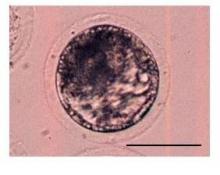Pictures and Feelings: How Journalists Slant the Abortion Issue
Pictures and Feelings: How Journalists Slant the Abortion Issue
We know by now that the anti-choice movement is fond of exaggerating the personhood of fetuses. It's not But even supposedly neutral media seems to like to depict pregnancy as a binary condition. Either you're not pregnant--through chastity and virginity, of course--or you're in your third trimester with a big ol' belly. I know that technically you're either pregnant or you're not, but there's a big biological difference between the first and third trimesters--a difference most of the media chooses to ignore in how they illustrate their abortion stories.
Most of the time, when a photo accompanies a news story about abortion, it'll be of a visibly pregnant woman. In some states, it's not even legal to abort when you're that far along. 90% of abortions are performed in the first trimester, before women even begin to show. Third trimester and partial birth abortions are performed rarely, and usually only to save the life of the woman or in the case of severe birth defects. Women considering early-term abortions aren't going to fit the societal image of the expectant mother. They're not harboring fully grown babies in their bodies, much as the right would like to think they are.
A similar technique is used by anti-choice shock groups who run campaigns featuring images of dead fetuses from partial-birth abortions. It's as if people can't grasp that pregnancy is a gradient, a long, slow process that turns cells into babies over the course of almost a year. Of course, this does make it tricky to draw the personhood line, especially considering how many premature babies go on to be healthy kids. But the first trimester seems to be a safe zone. Most abortions are performed long before the embryo starts to look like a human.
The choice to illustrate discussions on abortion laws with fully pregnant women seems a subversive move to perpetrate the idea that all fetuses are babies. Technically, it's not even a "baby" until it's born. Doctors will use the word "baby" instead of "embryo" or "fetus" because it sounds less clinical and makes future mothers feel more comfortable, but it's not a biologically accurate term. Really, until it's breathing on its own, it's still a fetus. But the panic of the right tends to gloss over the scientific details, rendering fetuses at all stages as adorable babies--and more human than you.
It's troubling to see multiple media outlets subtly reinforcing the notion of aborted fetuses as fully grown babies, or at least more fully grown than they typically are. Media tends to go for illustrative shock, rather than accuracy, in their stories. They'd rather use an image that conveys the idea of a pregnant woman, rather than a realistic image of a woman considering abortion. It's just like how we see images of born or nearly-born babies in anti-choice campaigns: because blastocysts just aren't as cute.
The common mis-illustration seems like irresponsible journalism, if not implicitly partisan. These images of pregnant bellies were chosen to inspire a specific emotional response in readers--one that doesn't set the stage for a rational consideration of the issue. If journalists are going to report effectively on abortion laws, they shouldn't accompany their stories with images that carry a certain emotional slant. So much of the outcry against abortion and Planned Parenthood grows out of misinformation and panic, from statements "not intended to be factual". Displaying images that intend to be more illustrative than factual isn't going to help people grasp the real weight of these stories. It's only going to breed more irrational and emotional voter opinions on the issue, which will further hinder reproductive rights.
(via Sociological Images)



